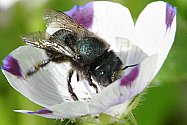WASHINGTON — Beautiful wildflowers, perhaps as alluring to bees as they are to people, might someday be planted in “bee pastures.” These floral havens would be created to help propagate larger generations of healthy, hard-working bees.
Pesticide-free bee pastures can be “simple to establish and — at perhaps only a half-acre each — easy to tend,” says entomologist James H. Cane of the Agricultural Research Service’s Pollinating Insects Biology, Management and Systematics Research Unit in Logan, Utah.
Cane has conducted bee-pasture-related experiments for about four years, working both in a research greenhouse and at outdoor sites in Utah and California. He says species of pastured pollinators could include, for example, the blue orchard bee, Osmia lignaria. This gentle bee helps with pollination tasks handled mainly by the nation’s premier pollinator, the European honey bee, Apis mellifera.
Today, millions of bees are needed every year to pollinate orchards and fields. Planting pastures for native blue orchard bees, for instance, could help meet that need. Cane estimates that, under good conditions, blue orchard bee populations could increase by as much as four- to fivefold a year in a well-designed, well-managed bee pasture.
Example
Cane gives this brief explanation of how the pasture idea would work: Blue orchard bees would be taken out of a bee manager’s winter storage and brought to the pasture, where they would emerge from their cocoons, mate, and, if female, lay eggs, before dying.
The following year, some of the new generation of bees that developed from those eggs would be brought to commercial almond orchards to pollinate the trees’ cream-white blooms. But most of that generation would be returned to their parents’ pasture to produce yet another, hopefully larger, generation.
Ideally, this cycle would continue year after year, with each year’s new generation larger than the one it replaced.
In their experiments, Cane and colleagues have studied wildflowers that might be ideal for planting at bee pastures in California. In particular, the team was interested in early-flowering annuals that could help bolster populations of blue orchard bees needed for pollinating California’s vast almond orchards.
Best flowers
The research resulted in a first-ever list of five top-choice, bee-friendly wildflowers for tomorrow’s bee pastures in almond-growing regions. These native California plants are: Chinese houses (Collinsia heterophylla), California five-spot (Nemophila maculata), baby blue eyes (N. menziesii), lacy or tansy phacelia (Phacelia tanacetifolia) and California bluebell (P. campanularia).
Though blue orchard bees gathered nectar and pollen from all of these species — a key requirement for wildflowers on the list — the bees’ obvious favorite was the bright-pink blossoms of the Chinese houses plants.
Wildflower species had to have more attributes than merely appealing to bees, however. Cane’s team made sure that each of the select species flourishes in the same climate and soil as that of almond orchards, and that the wildflowers bloom at about the same time of year as those trees.
These features help make it feasible and practical for bee managers who are busy fulfilling a commercial almond pollination contract to — at the same time — manage a bee pasture.
Additionally
The wildflowers also met other criteria: They are rich in pollen and nectar and are reasonably easy to grow and their seed is commercially available.
There was yet more that the researchers determined before deciding that the wildflowers were pasture-perfect.
For example, the scientists either newly determined or confirmed the amount of pollen and nectar produced by the plants, and they noted the timing and duration of the bloom.
They estimated how many flowers were produced per acre, then calculated the “carrying capacity” of each species, that is, the number of blue orchard bees that these plants could nourish.
Cane estimates that every 10 square yards of pasture that is planted with a mix of these five attractive flowers could provide enough pollen and nectar to support 400 mother bees. In turn, these pastured parents could produce enough progeny to — the following year — pollinate 3 acres of almond trees.
Currently
Two bee businesses in California are already using the findings to propagate more bees, Cane notes.
He collaborated in the research with support scientist Glen Trostle at Logan; former Logan technician Stephanie Miller; AgPollen LLC colleague Steve Peterson and others. ARS and the Modesto-based Almond Board of California funded the studies.
Cane notes that the bee-pasturing approach could perhaps be developed for other regions where other tree crops that blue orchard bees pollinate are grown, such as the cherry, apple or pear orchards of the Pacific Northwest.
Previously
Bee pasturing isn’t a new idea. But the studies by Cane and his collaborators are likely the most extensive to date. For the foreseeable future, bees will remain in great demand. And the bee pastures that Cane proposes are in perfect harmony with the pollination needs of almond blossoms and wildflowers alike.
“Bee pasturing,” he says, “is an efficient, practical, environmentally friendly, and economically sound way for bee managers to produce successive generations of healthy young bees.












I leave a couple acres of pasture unmowed every summer with a variety of flowering plants, have a maple tree with a hive of honeybees in it, and for some reason this year there seem to be a lot of butterflies too.